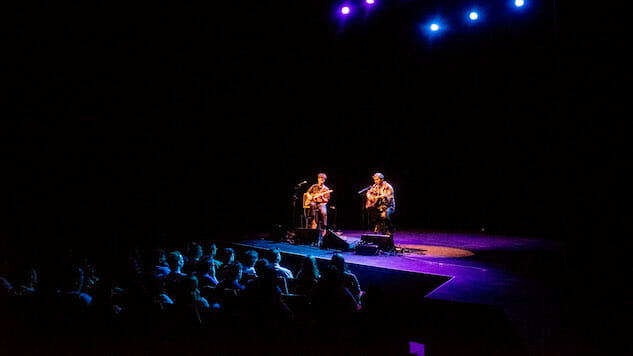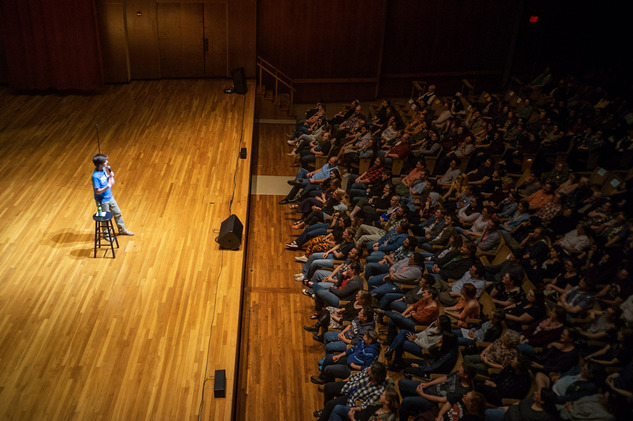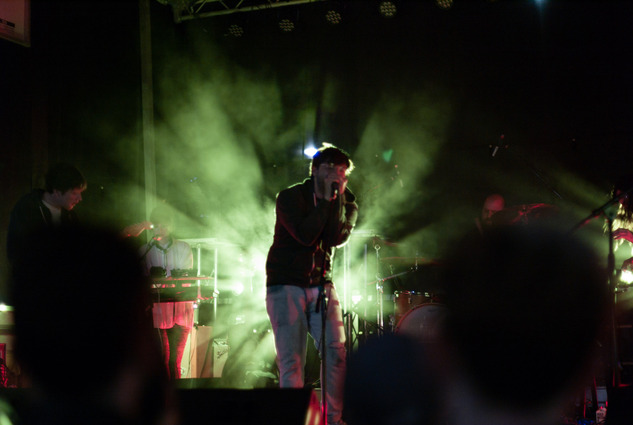A Tale of Two Cities: Illinois’ Pygmalion Festival Straddles Campus Culture and Community Arts
The music & arts festival gets it right for college-aged folks and community members alike.
All photos by Sam Logan Music Features Pygmalion Festival
When I was driving down to Champaign-Urbana, Ill., from Chicago to cover the Pygmalion Festival, I kept my eyes peeled for Champaign’s City Hall. It’s always acted as a sort of beacon for me—it’s the first, well, thing that’s not corn after miles of Midwestern emptiness, and its angular, lighted roof is instantly recognizable among the formless apartment complexes dotting the landscape around the University of Illinois campus. It’s always acted as a signal, a sign that I’d survived the long drive and civilization is imminent.
When I pulled off the highway around 10 p.m. that night and saw it in the distance, it felt like there was proof I was finally back. But when I got to Campustown, “civilization” was not what I remembered it to be. The streets were different—there were new sidewalks and streetlights and a big fancy sign saying “CAMPUSTOWN” where before there was just a rusting overpass. New high-rises seemed to tower over every corner. Some of the old haunts were gone, of course. This is to be expected—slow march of time and all that. But the speed with which campus had developed was still shocking.
Pygmalion Festival, which took place from Sept. 26-29 this year, has increasingly represented a different kind of development over its nearly 15-year existence. While Campustown is flooded with endless property schemes, the festival has provided a platform for Champaign-Urbana’s vibrant arts community to rally around since its creation in 2005. This is, after all, the town that’s home to the American Football house, and it has a storied history of DIY music and art communities. Pygmalion started as a music festival but has grown to include literature, technology, comedy and local artisan activations in recent years.
The enigma of University of Illinois is that while it straddles the border between the cities of Champaign and Urbana, the campus is in most ways its own city, vastly different from the surrounding areas. This is, again, to be expected. But the campus is different in other, more structural ways as well. Real estate development has grown exponentially in recent years. Those new high-rises are yearly occurrences, and they’re usually flimsy and slapped-together, far cries from the sturdy city hall roof that guided me into port. They’re not beacons so much as formless blobs, especially when compared to the old buildings populating Champaign and Urbana. Chain restaurants have taken over the main street, and the campus bars have for the most part become consolidated under the same company that owns much of the real estate. There’s a sense of cultural homogenization, especially as the school becomes more focused on its status as a STEM and business-based institution.
Pygmalion Festival is an antithesis to this path of development. While the school focuses on a select few priorities, Pygmalion seemingly expands its focus every year to include as many different cultural activations as it can. During the three days I spent at the festival, a dichotomy emerged between residents and students in terms of what aspects they found most interesting. Pymgalion’s great dilemma, and ultimately its great triumph, comes from navigating this dichotomy and emerging with something that appeals to both the University of Illinois and its surrounding communities, if not always in equal parts.
Before we get into the nitty-gritty, you should probably get an idea of how things generally look at the Pygmalion Festival. The festival is laid out in a similar fashion to South by Southwest: Instead of one massive outdoor area, performances are spread across multiple venues, with shows often happening concurrently. In between shows are poetry readings, keynote speakers, craft fairs, hack-a-thons and more.
The big-name performances were split between four places, most within a few blocks’ radius of each other. Krannert Center, an enormous music building with multiple auditoriums, played host to a few comedy sets and intimate music performances, and its massive lobby housed virtual reality demonstrations and readings from published writers like Jensen Beach and Paige Lewis. There was also a symphonic tesla coil performance in a small outdoor amphitheater. Then there’s Canopy Club, a deceptively spacious venue. There’s two stages there, one smaller and more dive-bar-ish, the other more expansive and theatrical. The Pygmalion Street Stage was an outdoor venue with food trucks, craft tents and other classic street-festival attractions, located right outside the Canopy Club.
A handful of performances happened at the Independent Media Center, an off-campus arts and media incubator located in downtown Urbana featuring an intimate stage. Smaller events emerged at coffee shops, museums, and lecture halls around campus, and the Pygmalion Hack-a-thon took place at EnterpriseWorks at Research Park.
This layout was different from when I last attended the festival in 2016, and it showed Pygmalion itself is not immune to the changes wrought across campus. In years past, the festival was equally distributed across Champaign, Urbana and Campustown, but this year, almost all of the events were located on campus near the quad. This decision seems to be based on an attempt to break through to an increasingly insular campus environment. Founder Seth Fein told Buzz Magazine that he was “very committed to the idea that Pygmalion has to appeal to a younger demographic to stay relevant and fun.”
In that sense, the problem for Pygmalion this year was getting the right people in front of the right performers. Thursday night’s big performance at the Krannert Center was from comedian Tig Notaro, who delivered a laid-back and improvisational monster-of-a-set lasting an hour-and-a-half. Her wide-ranging appeal among people of all ages was an obvious drawing point, and the crowd proved she was a wise choice: it was probably the most heterogeneous of the weekend.
Following Tig was Chicago-based indie-rock band Whitney, who delivered a stripped-down, acoustic set to a crowd consisting mostly of the type of people I expected to see at the festival: young college students who knew all the words, wrapped up in each other or the music or both. Their skeletal songs allowed singer Julien Ehrlich and guitarist Max Kakacek the space to let their country songwriting influences shine, especially Kakacek’s slippery, chicken-scratch fretwork. The duo debuted four new songs, work-in-progress sketches they joked through with the crowd. The open, democratic nature of both performances was a promising sign that the performer and audience were in sync with one another.
If Thursday’s crowd was an experience in age diversity, then Friday belonged to the youth. Starting things off was NPO, a Chicago-based rapper and producer whose immediate and easy-going flows rocked the crowd into a sort of reverie. Then came JPEGMAFIA, who was quite a change. Where NPO’s set had the crowd swaying, JPEG had the crowd frothing at the mouths. He was part dragon, part dragon-slayer, and he hulked through the crowd, climbing whatever he could find. Whatever the opposite of an exorcism is called, that’s what JPEG did to his young audience.
Following JPEG was Kweku Collins, another Chicago-based rapper who has made his name doing the sort of conscious groove-rap the city is known for. However, he was the first sort mis-step by the festival. He’s an excellent performer and an eminent showman, but his low-key conscious rap style was no match for an audience who’d been whipped into a frenzy just before he went on. The crowd seemed to have no desire for consciousness after having it so thoroughly ripped from them during JPEG’s set, and the numbers dwindled pretty heavily until Collins was left rapping to a mostly empty room.
Something similar happened at the Canopy Club for Mount Kimbie’s set. Opener Cuco gave a divinely blissed-out performance to a packed house of adoring fans, and it seemed Mount Kimbie’s performance would grow naturally out of Cuco’s hype. But by the time Mount Kimbie took the stage, the hall had emptied by half. They played on valiantly, delivering a set atmospheric in the sense that it seemed to replace all the air in the room with music, but the emptiness was noticeable, confusing and a bit disheartening to see.
In between the ticketed performances were a whole lot of free events, like poetry marathons, tech talks, and virtual reality demonstrations. It was a forum in the truest sense of the word, a place where people met, talked and shared. It was at these events where the scopes of Champaign-Urbana, and the Pygmalion Festival, shined. There were middle-aged residents, hip elderly folks, jacket-patch professors, local artisans and even elementary-aged children mixed in with the college students. Pygmalion’s cultural vision was on display most clearly not at the music performances, but at all the things happening in between. It’s a vision of a university and the surrounding community partaking in a vast interchange of ideas.
Saturday was the last day of the festival and the coldest day yet in a progressively cooling weekend, and I expected turnout to drop. I was wrong. At the IMC, Chicago-based group V.V. Lightbody gave a confident set of gnarled indie-pop island music to a crowd of eager listeners, while headliner Frankie Cosmos proved her staying power with a huge set that felt incredibly small, even with all the people packing the hall. She drew power from how easy she made it look, and the crowd seemed to grow more enchanted as the set went on. At the street stage, Foxing proved emo was alive and well with a dynamic, scream-filled set that rattled the ground.
I didn’t see Playboi Carti, arguably the biggest name of the weekend, but I did see the crowd lining up for his show at Canopy while Foxing performed. Those fans represented another faction of the university, one that I hadn’t seen much of at the festival and, to be honest, seemed surprised to learn a festival was even happening. Their surprise was symptomatic of something that had bothered me the entire time I spent here. I was staying on the other side of campus from where Pygmalion was taking place, in an area congested with those new apartments I mentioned earlier, and the students filling those new high-rises seemed, for the most part, unaware of Pygmalion’s possibilities lurking at the fringes of the world they operated in.
My cynicism was dashed by the set from Chicago-based psych-rockers Post Animal, who closed out the night at the IMC. It was everything I had hoped for, all wild mosh pits and crowd-surfers and spinning, thrashing dance moves. Their set was an affirmation that the kids are alright, that music still finds them, still moves them to punch the air and kick the ceiling and shriek the night away. All my concerns about how the little things had changed were laid to rest, because it showed me the big things hadn’t. For all its changes, Pygmalion is still breaking through to the kids who need music to show them they’re alive. More importantly, it’s still connecting those lives in ways they wouldn’t have been connected otherwise. The grand experiment soldiers on. It’s as much a beacon as that city hall I watched for on my drive down. It just looks a little different, is all.

